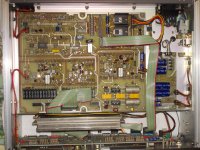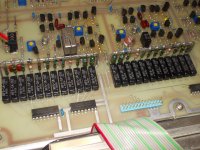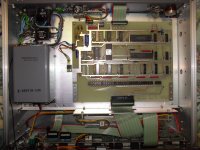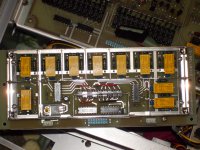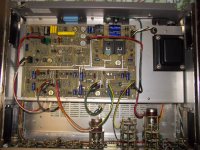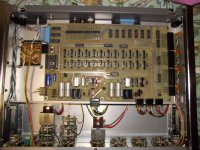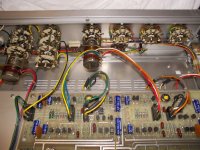since the opa1642 has been discussed here I thought I would post a link to one reason HOW the distortion is reduced at the input in the newer FET input type opamps. From TI application notes.
http://www.ti.com/general/docs/lit/getliterature.tsp?baseLiteratureNumber=slyt595&fileType=pdf
Cheers,
Alan
http://www.ti.com/general/docs/lit/getliterature.tsp?baseLiteratureNumber=slyt595&fileType=pdf
Cheers,
Alan
I got shibasoku AG16A.
4th picture is relay attenuator that is shielded can you can see in 1st picture.
bottom left relay is wrong orientation because I pulled from socket and set as it...
I do not own distortion analyzer so I will test with EMU 1616m.
4th picture is relay attenuator that is shielded can you can see in 1st picture.
bottom left relay is wrong orientation because I pulled from socket and set as it...
I do not own distortion analyzer so I will test with EMU 1616m.
Attachments
Got to love those power transformers Shibasoku uses.
I picked up a Shibasoku 725C a few weeks ago. Have to include it as one of my best buys.
Truly a remarkable machine. Still SOTA.
Shinja do you have access to Shibasoku manuals?
I have the manual for the 725B but would like one for the 725C.
Cheers,
I picked up a Shibasoku 725C a few weeks ago. Have to include it as one of my best buys.
Truly a remarkable machine. Still SOTA.
Shinja do you have access to Shibasoku manuals?
I have the manual for the 725B but would like one for the 725C.
Cheers,
I contacted shibasoku for manuals-AG16A and 725C,D but I got no reply yet.
My AG16A result below -120dB of THD+N at 1kHz BW22kHz tested with twin-t notch filter on bread board and 1616m...It looks okay.
I also own 590R that THD+N was about -106dB ,dominated by 2nd HD at about -110dBr, but 3HD is around -130dBr.
http://www.diyaudio.com/forums/equi...n-audio-range-oscillator-309.html#post3601862
Demian wrote his 590AR reduced its 2nd HD adjusting offset pot ,but my 590R did not respond so drastic...at best only around 3dB improvement ,in exchange for stability ,when turning left pot too much there appears weird high order distortions like clipping in FFT.
It may nearly reach slew rate limit due to unballancing LTP too much, but oh I forgot to check each source currents of FETs.
My AG16A result below -120dB of THD+N at 1kHz BW22kHz tested with twin-t notch filter on bread board and 1616m...It looks okay.
I also own 590R that THD+N was about -106dB ,dominated by 2nd HD at about -110dBr, but 3HD is around -130dBr.
http://www.diyaudio.com/forums/equi...n-audio-range-oscillator-309.html#post3601862
Demian wrote his 590AR reduced its 2nd HD adjusting offset pot ,but my 590R did not respond so drastic...at best only around 3dB improvement ,in exchange for stability ,when turning left pot too much there appears weird high order distortions like clipping in FFT.
It may nearly reach slew rate limit due to unballancing LTP too much, but oh I forgot to check each source currents of FETs.
Attachments
comparing his 590AR and my 590R, http://www.diyaudio.com/forums/equi...n-audio-range-oscillator-181.html#post3393158
they looks almost identical except minor changes.
trafo R:shielded tube amp like mount type AR:heavily shielded gray trafo?
LTP JFETs R:dual 2SK97 AR:single ???
compensations of two discrete opamps (relate to above jfets)
top left, neighbor to MC1495, socketted DIP reed relay
I partially traced the circuits and found they are consists of two all pass filters = phase shifter.
AGC circuit is complicated and bit hard to trace, also in AG16A.
they looks almost identical except minor changes.
trafo R:shielded tube amp like mount type AR:heavily shielded gray trafo?
LTP JFETs R:dual 2SK97 AR:single ???
compensations of two discrete opamps (relate to above jfets)
top left, neighbor to MC1495, socketted DIP reed relay
I partially traced the circuits and found they are consists of two all pass filters = phase shifter.
AGC circuit is complicated and bit hard to trace, also in AG16A.
since the opa1642 has been discussed here I thought I would post a link to one reason HOW the distortion is reduced at the input in the newer FET input type opamps. From TI application notes.
Thanks for posting the link!
Up until now the only app note I've been able to find on op-amp input impedance distortion is this old one from LT. The TI article seems pretty recent with 4th quarter 2014 in the page footer. The TI app note is especially helpful since at the bottom of page 6 they have links to the OPA140 and OPA827 web pages, the two chips I'm using as luck would have it, which makes me think they may use this same fab process.
Last edited:
If I end up with something satisfying (and I'm positive I will) you'll get Gerbers (or perhaps PCBs).
Samuel
Hi,
What is your progress now?
THx-RNMarsh
What is your progress now?
Most of the layout is done, remaining are the output attenuators and perhaps some changes to the output amplifiers.
Samuel
Hi all,
Perhaps the experts here can help me with my question:
Which DAC can you recommend for a general purpose audio oscillator (1Hz - 200 kHz, for sine, multi-sine, rectangle, MLS, sine bursts, pink noise and other typical test signals)?
I do not need the lowest possible THD specification, but want a good general purpose oscillator with better specifications and a higher upper frequency limit than the typical soundcard.
Do you know what AP uses in their newer systems? How do they design the anti-aliasing filter?
Thanks,
Udo
Perhaps the experts here can help me with my question:
Which DAC can you recommend for a general purpose audio oscillator (1Hz - 200 kHz, for sine, multi-sine, rectangle, MLS, sine bursts, pink noise and other typical test signals)?
I do not need the lowest possible THD specification, but want a good general purpose oscillator with better specifications and a higher upper frequency limit than the typical soundcard.
Do you know what AP uses in their newer systems? How do they design the anti-aliasing filter?
Thanks,
Udo
Hi all,
Perhaps the experts here can help me with my question:
Which DAC can you recommend for a general purpose audio oscillator (1Hz - 200 kHz, for sine, multi-sine, rectangle, MLS, sine bursts, pink noise and other typical test signals)?
I do not need the lowest possible THD specification, but want a good general purpose oscillator with better specifications and a higher upper frequency limit than the typical soundcard.
Do you know what AP uses in their newer systems? How do they design the anti-aliasing filter?
Thanks,
Udo
I'm not sure what you're asking for here. Do you mean you was to synthesize a sine using a DAC?
I do not know about a DAC solution without a ton of software/DSP code.
HP 3325A/B will cover most required functionality.
You can also look at the obsolete Maxim MAX038 or older yet Exar XR 2206 for some of these functions.
Mixing to sines requires two separate oscillators, unless it is done in DSP.
I have not graduated to write DSP code yet. Look at some Elektor DSP projects, might help you there.
Putting all this functionality into "a one device special" is not so easy to DIY, unless someone else has done it and sells it.
HP 3325A/B will cover most required functionality.
You can also look at the obsolete Maxim MAX038 or older yet Exar XR 2206 for some of these functions.
Mixing to sines requires two separate oscillators, unless it is done in DSP.
I have not graduated to write DSP code yet. Look at some Elektor DSP projects, might help you there.
Putting all this functionality into "a one device special" is not so easy to DIY, unless someone else has done it and sells it.
Hi all,
Perhaps the experts here can help me with my question:
Which DAC can you recommend for a general purpose audio oscillator (1Hz - 200 kHz, for sine, multi-sine, rectangle, MLS, sine bursts, pink noise and other typical test signals)?
I do not need the lowest possible THD specification, but want a good general purpose oscillator with better specifications and a higher upper frequency limit than the typical soundcard.
Do you know what AP uses in their newer systems? How do they design the anti-aliasing filter?
Thanks,
Udo
Try ESS.
-RNM
the Schiit Yggdrasil DAC may be interesting - we should see soon how well they tamed glitch spoiling the AD5791 20 bit DAC dynamic datasheet spec - 100/97 dB 1 kHz SFR/THD from a 20 bit DAC?
the device could give ridiculous S/N if the Vref are maxed out
the DNL looks like ~ 0.6 lsb, the inl is a little more choppy - likely from the 63 segmented R implementing the 6 msb
large signal noise shaped and/or subtractive dither has the possibility of smoothing out the bit errors in the audio band
the device could give ridiculous S/N if the Vref are maxed out
the DNL looks like ~ 0.6 lsb, the inl is a little more choppy - likely from the 63 segmented R implementing the 6 msb
large signal noise shaped and/or subtractive dither has the possibility of smoothing out the bit errors in the audio band
Last edited:
Hi all,
Perhaps the experts here can help me with my question:
Which DAC can you recommend for a general purpose audio oscillator (1Hz - 200 kHz, for sine, multi-sine, rectangle, MLS, sine bursts, pink noise and other typical test signals)?
I do not need the lowest possible THD specification, but want a good general purpose oscillator with better specifications and a higher upper frequency limit than the typical soundcard.
Do you know what AP uses in their newer systems? How do they design the anti-aliasing filter?
Thanks,
Udo
Udo,
The ESS can perform many tricks - you can input data directly (bypassing the digital filter) - so you can push it to about 1.5MHz with filter bypassed - you have to be aware that the ESS9018 has many undocumented bugs and performance issues, but you can find ways around most of them.
I'm just working on a reference design which combines the ESS9018 with FPGA + DSP with USB interface so maybe we can accommodate your requirements - the PCB also has a pair of ADC's...
The design should be over 130dB DR, pushing closer to 135dB, it just depends on your requirements.
We should meet
Just curious how close you could get with Audacity and a good sound card? You probably could trim out constant L-R differences with resistor networks. Given an accurate digital representation, what kind of distortion figures would you get? What happens to distortion at higher frequencies as samples per Hz diminishes?
I have some material regarding this issue:
Eamples of Sine Wave Generation in audio systems - 2005
Discrete DDS always produces Jitter which has to by smoothed over several stages before feeding a second DDS creating the desired wave, like eg sine.
http://www.96khz.org/oldpages/limitsofdds.htm
Eamples of Sine Wave Generation in audio systems - 2005
Discrete DDS always produces Jitter which has to by smoothed over several stages before feeding a second DDS creating the desired wave, like eg sine.
http://www.96khz.org/oldpages/limitsofdds.htm
- Home
- Design & Build
- Equipment & Tools
- Low-distortion Audio-range Oscillator
